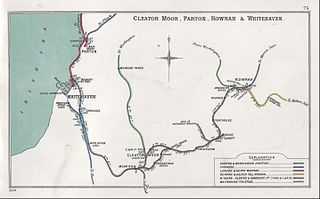The North Western Railway (NWR) was an early British railway company in the north-west of England. It was commonly known as the "Little" North Western Railway, to distinguish it from the larger London and North Western Railway (LNWR).

Clapham is a railway station on the Bentham Line, which runs between Leeds and Morecambe via Skipton. The station, situated 48 miles (77 km) north-west of Leeds, serves the village of Clapham in North Yorkshire. It is owned by Network Rail and managed by Northern Trains.

Tebay railway station was situated on the Lancaster and Carlisle Railway (L&CR) between Lancaster and Penrith. It served the village of Tebay, Cumbria, England. The station opened in 1846, and closed on 1 July 1968.

Abergavenny railway station was a station on the London and North Western Railway's Heads of the Valleys line serving the town of Abergavenny in the Welsh county of Monmouthshire.
Abergavenny Junction railway station was a station situated near the junction made between the London and North Western Railway's Heads of the Valleys line and the West Midland Railway's Newport, Abergavenny and Hereford Railway, which served the town of Abergavenny in the Welsh county of Monmouthshire.

The Chard branch lines were two lines serving the town of Chard in Somerset, England. One was a northward branch, opened in 1863, from the Salisbury to Exeter main line, and the other, opened in 1866, ran south-eastwards from the Bristol – Taunton main line. Each branch had its own Chard passenger station at first, although the two lines connected in Chard.

Witney railway station served the Oxfordshire town of Witney on the Oxford, Witney and Fairford Railway line. It consisted of two stone-built platforms, a station building, a signal box, and a shed in the form of a pagoda.

The Ingleton branch line was a rural railway line in the West Riding of Yorkshire, Lancashire and Westmorland in England. It was originally planned in 1846 to form part of a main line route from London to Scotland, but fell victim to rivalry between railway companies. Completion was delayed until 1861, and it was only ever a rural branch line, serving the village of Ingleton and towns of Kirkby Lonsdale and Sedbergh. It closed to passengers in 1954 and was dismantled in 1967.
Ingleton (Midland) railway station was one of two stations serving the village of Ingleton, North Yorkshire, England. It was originally open for just ten months between 1849 and 1850, and did not reopen until 1861. It then served as the frontier between the Midland Railway to the south and the London and North Western Railway to the North, with trains from each railway terminating at the station. Through trains did not begin until the two companies were merged in 1923. The station closed in 1954. The village's Community Centre is now on the site of the former station.
Ingleton (L&NW) railway station was one of two stations serving the village of Ingleton, North Yorkshire, England. It owed its existence to the intense rivalry between the two stations' owners. It opened, along with the Ingleton Branch Line, in 1861, and closed in 1917, by which time the two railway companies had become more cooperative.

Grayrigg railway station in Lambrigg parish, was situated on the course of the original Lancaster and Carlisle Railway (L&CR) between Lancaster and Penrith. It served the village and rural district of Grayrigg, Cumbria, England. The new station opened in November 1849, and closed on 1 February 1954 replacing the L&CR station that was located two miles (3.2 km) west of the station and closed in 1849.

Barbon railway station was located in Westmorland, England, serving the town and locale of Barbon on the Ingleton Branch Line.

Kirkby Lonsdale railway station was located in Lancashire, England, on the Ingleton Branch Line, 2 miles (3 km) from the town of Kirkby Lonsdale in Westmorland.
Middleton-on-Lune railway station was located in Westmorland, England,, serving the hamlet and rural locale of Middleton on the Ingleton Branch Line. It was opened as Middleton in 1861 and renamed Middleton-on-Lune on 19 July 1926, closing in 1931.

Staveley Town is a disused railway station in Staveley, Derbyshire in England.

Rowrah railway station was built by the Whitehaven, Cleator and Egremont Railway. It served the village of Rowrah, Cumbria, England.
Ullock railway station was built by the Whitehaven, Cleator and Egremont Railway. It served the village of Ullock, Cumbria, England.
Lamplugh railway station was built by the Whitehaven, Cleator and Egremont Railway. It served the scattered community of Lamplugh, Cumbria, England.

Winder railway station was built by the Whitehaven, Cleator and Egremont Railway. It served the village of Winder, Frizington, Cumbria, England.
Egremont railway station was built by the Whitehaven, Cleator and Egremont Railway as the first southern terminus of what would become the Moor Row to Sellafield branch. In 1878 the company was bought out by the LNWR and Furness Railway who operated the line jointly until grouping in 1923.












